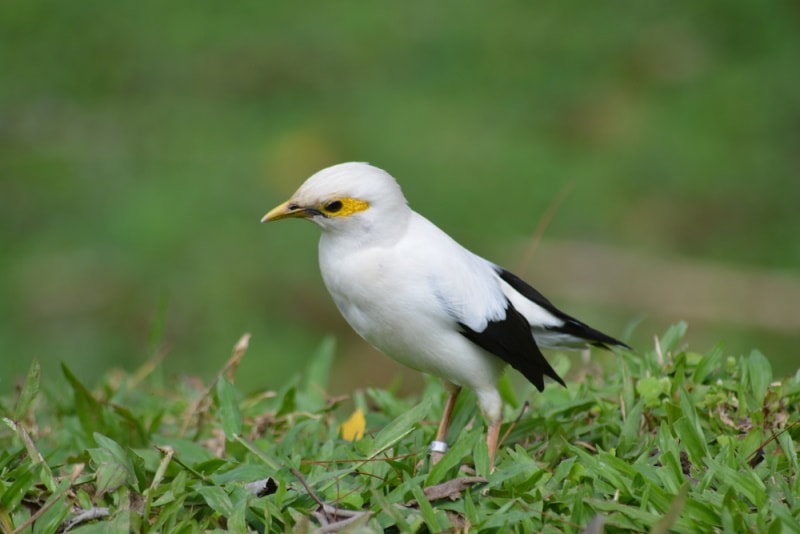Black-Winged Starling: Field Guide, Pictures, Habitat & Info
Last Updated on

While European starlings are an invasive species that’s pushing their numbers out into the world, their lesser-known cousin, the black-winged starling, isn’t quite as fortunate.
They’re extremely beautiful and active birds that live near the Java Sea in Indonesia, but that’s not all you need to know about them. We break it all down for you here.

Quick Facts About the Black-Winged Starling

| Twig-lined | Tropical dry forests, tropical shrubland, and pastureland |
| Diet | Fruit, nectar, and insects |
| Behavior | Active, stays in groups, monogamous mating habits |
| Nesting | Twig-lined rock or tree hole |
| Conservation | Critically endangered |
| Scientific name | Acridotheres melanopterus |
| Lifespan: | 2 to 3 years |
Black-Winged Starling General Description
The black-winged starling is a mostly white bird with black wings. They also have splashes of yellow around their beady black eyes and a long beak.
When their wings are closed, it can look like they have black backs, but when they’re in flight, you can see that their back is actually white. They’re impressive-looking birds that stand out from the rest of the starling family.
Black-Winged Starling Range, Habitat, Behavior, Diet & Nesting
Range
The black-winged starling doesn’t currently have much of a range, only living in very small regions in Singapore and Malaysia, all around the Java Sea. They prefer living at sea level, but you can find them as high as 2,400 feet.
Habitat

While there aren’t many black-winged starlings around, they do have a diverse set of potential ranges. They can live in tropical dry forests, tropical shrublands (both wet and dry), and pasturelands.
They live just about everywhere within their range, but due to their dwindling numbers, they can be challenging to spot.
Behavior
Unlike many birds that try to track down their food alone, the black-winged starling prefers to feed and roost in small groups or pairs. They’re active throughout the day and sleep at night. During the day, they’re active birds, jumping from place to place in search of food.
Diet
The black-winged starling has a varied diet, happily chowing down on fruit, nectar, and insects alike. They like grasshoppers, beetles, termites, caterpillars, and any other insects that they can get their beaks on.
Nesting
Black-winged starlings aren’t picky nesters, forming twig nests in either rocks or trees, but they seem to prefer higher elevations for their nests. They’re also likely monogamous breeders, picking a partner and sticking with them season after season.
How to Find Black-Winged Starlings: Birdwatching Tips
What to Listen For
The black-winged starling doesn’t have an extremely distinctive call, but they are active and noisy. Their calls can last upward of 15 seconds at a time, giving you plenty of time to spot them when they start calling.
What to Look For
When you’re trying to spot a black-winged starling, it’s all about finding the signature mix of white-and-black feathers. Then, look for the signature yellow around the eyes to confirm that you’re seeing a black-winged starling.

When to Look
If you’re looking for a black-winged starling, head out in the early hours of the morning during sunrise or at sunset. This is when the weather is cooler, and these birds will be the most active.
You can still spot them in the middle of the day, but they simply won’t be moving around as much then.
Attracting Black-Winged Starlings to Your Backyard: Tips & Tricks
While you might want to attract a black-winged starling to your backyard, unless you live by the Java Sea near Jakarta, Indonesia, that’s not going to happen.
However, if you do live in this region, there are a few things that you can do to try to attract these birds to your yard. Just keep in mind that since these are critically endangered birds, there are few left in the wild, dramatically reducing your chances of attracting any near your home.
- Put out a bird bath.
- Leave out nectar and fruits.
- Create a habitat where insects can thrive.
- Put out a bird box.

Black-Winged Starling Conservation: Is This Bird Threatened?
Not only is the black-winged starling endangered, but they are critically endangered. That puts them at the highest risk of extinction. It’s estimated that there are no more than 100 individual birds left in the wild.

Final Thoughts
Now that you know more about the black-winged starling, it’s up to you to figure out how to spot one. The only way to see one in the wild is to head out to Indonesia, but due to their rapidly dwindling numbers, you’re probably better off finding a zoo that has them.
Either way, they’re beautiful birds that are a real joy to see flying around!
Featured Image Credit: Eko Budi Utomo, Shutterstock
Table of Contents
- Quick Facts About the Black-Winged Starling
- Black-Winged Starling General Description
- Black-Winged Starling Range, Habitat, Behavior, Diet & Nesting
- How to Find Black-Winged Starlings: Birdwatching Tips
- Attracting Black-Winged Starlings to Your Backyard: Tips & Tricks
- Black-Winged Starling Conservation: Is This Bird Threatened?
- Final Thoughts
About the Author Robert Sparks
Robert’s obsession with all things optical started early in life, when his optician father would bring home prototypes for Robert to play with. Nowadays, Robert is dedicated to helping others find the right optics for their needs. His hobbies include astronomy, astrophysics, and model building. Originally from Newark, NJ, he resides in Santa Fe, New Mexico, where the nighttime skies are filled with glittering stars.
Related Articles:
10 Types of Hummingbirds in Arkansas (With Pictures)
8 Types of Hummingbirds in Nebraska (With Pictures)
5 Types of Hummingbirds in Idaho (With Pictures)
3 Types of Hummingbirds in Mississippi (With Pictures)
8 Types of Hummingbirds in Kansas (With Pictures)
5 Types of Hummingbirds in West Virginia (With Pictures)
5 Types of Hummingbirds in Ohio (With Pictures)
Where Do Nuthatches Nest? Nuthatch Nesting Habits Explained
